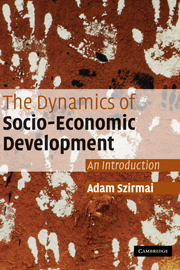Book contents
- Frontmatter
- Contents
- List of figures
- List of tables
- List of boxes
- Preface
- List of abbreviations
- Acknowledgements
- Chapter 1 Developing countries and the concept of development
- Chapter 2 Development of the international economic order, 1450–2000
- Chapter 3 Growth and stagnation: theories and experiences
- Chapter 4 Technology and development
- Chapter 5 Population and development
- Chapter 6 Health, health care and development
- Chapter 7 Education and development
- Chapter 8 Economic development, structural transformation and primary exports
- Chapter 9 Industrial development
- Chapter 10 Agricultural development and rural development
- Chapter 11 State formation and political aspects of development
- Chapter 12 Cultural dimensions of development
- Chapter 13 The international economic and political order since 1945
- Chapter 14 Foreign aid and development
- Bibliography
- Author index
- Subject index
Chapter 3 - Growth and stagnation: theories and experiences
Published online by Cambridge University Press: 05 June 2012
- Frontmatter
- Contents
- List of figures
- List of tables
- List of boxes
- Preface
- List of abbreviations
- Acknowledgements
- Chapter 1 Developing countries and the concept of development
- Chapter 2 Development of the international economic order, 1450–2000
- Chapter 3 Growth and stagnation: theories and experiences
- Chapter 4 Technology and development
- Chapter 5 Population and development
- Chapter 6 Health, health care and development
- Chapter 7 Education and development
- Chapter 8 Economic development, structural transformation and primary exports
- Chapter 9 Industrial development
- Chapter 10 Agricultural development and rural development
- Chapter 11 State formation and political aspects of development
- Chapter 12 Cultural dimensions of development
- Chapter 13 The international economic and political order since 1945
- Chapter 14 Foreign aid and development
- Bibliography
- Author index
- Subject index
Summary
As discussed in the first chapters of this book, there has been long-run divergence in the world economy. In the fifteenth century disparities in per capita incomes between countries and regions were small. Since then some economies have moved ahead and others have fallen far behind. After 1820, capital accumulation and technological change accelerated. The rate at which income levels diverged increased, resulting in the wide global disparities of the present international economic order. We have also noted that the ranking of countries was not immutable. Former British colonies such as the USA, Canada and New Zealand or Asian economies such as Japan, Singapore and Korea grew so rapidly that they moved far up the income ladder. Other countries such as Argentina, the Ottoman empire or the Russian Federation slipped downward. For a better understanding of development, we are interested in why some countries or societies forge ahead in given periods, while others stagnate or fall behind (Abramovitz, 1989b). We are especially interested in the conditions under which growth and catch-up can be realised in the developing countries of today. Sections 3.1 to 3.5 of this chapter offer a brief introduction to theories of growth and stagnation. Section 3.6 presents theoretically relevant empirical information on long-run economic trends in developing countries.
What are the basic sources of growth? How do economies grow and societies become more prosperous?
Let us start with the question of what are the basic sources of growth of per capita incomes. In simplified form, these are summarised in Box 3.1.
- Type
- Chapter
- Information
- The Dynamics of Socio-Economic DevelopmentAn Introduction, pp. 68 - 116Publisher: Cambridge University PressPrint publication year: 2005



